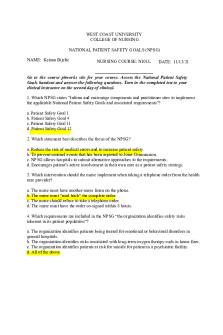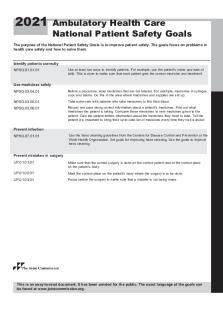Short Paper 2.2 Role of Accreditation in Ensuring Patient Safety PDF

| Title | Short Paper 2.2 Role of Accreditation in Ensuring Patient Safety |
|---|---|
| Author | Carrie Ferrell |
| Course | Healthcare Quality and Improvement |
| Institution | Southern New Hampshire University |
| Pages | 6 |
| File Size | 100.4 KB |
| File Type | |
| Total Downloads | 20 |
| Total Views | 146 |
Summary
This is a short paper in week two on the role of accreditation in patient safety....
Description
Journal
HealthCare Quality Improvement Short Paper 3.1 Critical Elements of a Quality Plan March 6, 2021 Carrie Ferrell Southern New Hampshire University
Journal
Role of Accreditation in Ensuring Patient Safety The accreditation process is when an organization providing services has an outside agency evaluate itself against predetermined guidelines and then certifies the results publicly. [ CITATION Nas19 \l 1033 ] The NCQA conducted its first accreditation of a health plan in 1991. While the Joint Commission first established its National Patient Safety Goals Program (NPSG) in 2002, the first set of NPSGs were not released until January 1, 2003. NPSG’s were developed to solve specific safety issues of patients. [ CITATION Joi21 \l 1033 ] A health plan’s overall accreditation is measured using their performance in three specific areas. These areas are clinical performance, member satisfaction, and compliance with standards and guidelines. [ CITATION Nas19 \l 1033 ] The guidelines for Accreditation are established and then reviewed regularly by the NCQA Standards Committee. These categories can include Quality Management and Improvement, Utilization Management, and Members Rights and Responsibilities, among others. Most organizations over several different product lines so accreditation status is determined by product line for POS, EPO, HMO, and PPO products. [ CITATION Nas19 \l 1033 ]
Patient Safety Patient Safety is of the upmost importance for an organization to keep in mind. An organization cannot hold a valid accreditation if their safety is not of the highest quality. Quality can be determined in multiple ways so heath care organizations must depend on regulatory agencies such as the Joint Commission, the Institute for Healthcare Improvement, the Agency for Healthcare Research and Quality (AHRQ), and the Centers for Medicare and Medicaid (CMS) to determine quality outcome achievements and establish benchmarks that show those standards. These regulatory agencies can help to give direction and guidance to healthcare providers,
Journal
companies, and other healthcare organizations so they can ensure patient safety while realizing quality cost-effective outcomes. Healthcare organizations must then use this guidance to establish methods that can establish ways to collect and measure the data that demonstrates compliance. The data can then be analyzed and compared to the established benchmarks. NPSG and Joint Commission The joint commission works to ensure they have the proper guidance when developing the National Patient Safety Goals. To accomplish this goal, the joint commission has established a committee of people that are recognized as experts in patient safety who advise them when they work on developing and making changes or updates to the NPSG. This group is called the Patient Safety Advisory Group and is made up of doctors, risk managers, nurses, pharmacists, and other professionals who have experience in patient safety and management [ CITATION Nas19 \l 1033 ]. With their input, the Joint Commission determines the biggest priorities for patient safety concerns. Then they determine the most effective way to correct these issues. Once they complete that process, they then must decide if this will apply to a certain section within an accreditation program and if it will then adjust that process accordingly. Consequences The consequences for direct impact standards, if any insufficiencies are found, is that the organization has 45 days to correct the issues. Once corrected, the organization must submit a form, known as the Evidence of Standards Compliance (ESC) form. The organization has 60 days for indirect impact standards. Accreditation will only be granted once criteria for all guidelines have been established. If the organization fails to comply with the Joint Commission’s established rules then the consequences will be denial and/or revocation of the accreditation
Journal
status [ CITATION Joi21 \l 1033 ]. This can have many adverse effects on the organization including the facility's finances [ CITATION Joi21 \l 1033 ]. Organization’s Readiness Each organization must be sure they are consistently meeting the guidelines each day. To accomplish this goal, each organization must perform a self-assessment on a consistent basis. This ensure they are prepared for the official survey. One excellent way to prepare for the official survey and evaluate their preparedness is to conduct mock surveys. The organization should treat these surveys as if they are the real thing following the official standards of the Joint Commission and the NPSGs. Not only does this allow the organization to evaluate its readiness, but it also helps staff feel better prepared for the actual meeting. This will improve an organizations outcome. It can also teach staff how to interact with interviewers which will help reduce any nerves or anxiety employees could have regarding the process. Actions As soon as the application has been submitted by the organization, then the accreditation process begins. The process also has a fee included. This fee is based on the location and size of the organization. Once these two items have been processed by the Joint Commission, the organization will provide a set of login credentials for their Connect portal. A surveyor is assigned at this point. The surveyor will execute both an unannounced and an announced survey. During this process it is vital that any organizational changes be given immediately to the Joint Commission. The public must also be informed that the organization is undergoing the accreditation process and where they can suggest any patient safety concerns. How long the survey takes can depend on the organization’s dimensions and intricacies. [ CITATION Joi21 \l 1033 ].
Journal
Conclusion The Joint Commission standards provide for an impartial evaluation process that allows health organizations to both measure and evaluate performance. These measures are then used to improve the organization. The standards established by the Joint Commission concentrate on the important areas of patient care as well as what is essential for an organization to succeed in providing quality, affordable, and safe care. The Joint Commission’s standards help to establish sensible, achievable, and valuable expectations of organizational performance. [ CITATION www21 \l 1033 ].
Journal
References JointCommission.org. (2021). What is the Joint Commission? . Retrieved from JointCommission.org: https://www.jointcommission.org/standards/national-patientsafety-goals/ Nash, D. B., Joshi, M. S., Ransom, E. R., & Ransom, S. B. (2019). The Healthcare Quality Book. Chicago: HealthAdministrationPress. World Health Organization (WHO). (2007). Patient identification. Patient Safety Solutions,. Retrieved from http://www.who.int/patientsafety/solutions/patientsafety/PS www.jointcommission.org. (2021). National Safety Patient Safety Goals. Retrieved from www.jointcommission.org: https://www.jointcommission.org/standards/national-patientsafety-goals/-/media/b35ba0b4b9754c6dbafdb1f86e152e5c.ashx...
Similar Free PDFs

PATIENT SAFETY
- 15 Pages

Modul Manajemen Patient Safety
- 60 Pages

Patient Safety - Notes
- 8 Pages

Accreditation Audit Task 2 paper
- 13 Pages

Short Paper
- 3 Pages

Role of Literature in Society
- 1 Pages

Role of conventions in uk
- 5 Pages
Popular Institutions
- Tinajero National High School - Annex
- Politeknik Caltex Riau
- Yokohama City University
- SGT University
- University of Al-Qadisiyah
- Divine Word College of Vigan
- Techniek College Rotterdam
- Universidade de Santiago
- Universiti Teknologi MARA Cawangan Johor Kampus Pasir Gudang
- Poltekkes Kemenkes Yogyakarta
- Baguio City National High School
- Colegio san marcos
- preparatoria uno
- Centro de Bachillerato Tecnológico Industrial y de Servicios No. 107
- Dalian Maritime University
- Quang Trung Secondary School
- Colegio Tecnológico en Informática
- Corporación Regional de Educación Superior
- Grupo CEDVA
- Dar Al Uloom University
- Centro de Estudios Preuniversitarios de la Universidad Nacional de Ingeniería
- 上智大学
- Aakash International School, Nuna Majara
- San Felipe Neri Catholic School
- Kang Chiao International School - New Taipei City
- Misamis Occidental National High School
- Institución Educativa Escuela Normal Juan Ladrilleros
- Kolehiyo ng Pantukan
- Batanes State College
- Instituto Continental
- Sekolah Menengah Kejuruan Kesehatan Kaltara (Tarakan)
- Colegio de La Inmaculada Concepcion - Cebu








